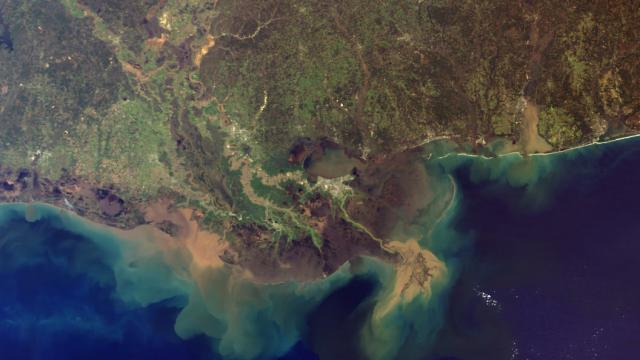The Midwest floods portended a bad year for the Gulf of Mexico’s dead zone way back in March—it was just a question of how bad things could get. Now with a few months more date, scientists have an answer.
On Monday, a number of research groups including the federal government released their forecasts for the dead zone, a vast region of oxygen-starved water that spreads across the Gulf of Mexico every summer. The forecast is an ugly one. According to the National Oceanic and Atmospheric Administration (NOAA) forecast, an area the size of Massachusetts could see an algae bloom that gobbles up oxygen and crowds out all aquatic life, creating an ecological and economic catastrophe. Other forecasts range even higher, but all peg this as one of the worst dead zones ever recorded in the Gulf of Mexico largely due to the Midwest floods.
NOAA’s forecast relies on a suite of models developed by its research partners. The amalgamation of those models shows the dead zone could reach 7,829 square miles later this summer. The team at Louisiana State University—which contributes a model to the NOAA suite—is forecasting a dead zone of 8,717 square miles, which would rival the largest dead zone ever recorded of 8,776 square miles set in 2017.
“When you get down it, [the forecasts] are not that much different,” Nancy Rablais, a marine ecologist at the Louisiana Universities Marine Consortium who worked on the LSU forecast, told Earther. “It’s going to be large, and that means it’s going to be too large.”
A tropical storm spinning up could help break up the dead zone and prevailing winds could push it around. But the volume of the low-oxygen zone itself is unlikely to change.
The Gulf of Mexico dead zone has become an annual occurrence largely due to farming practices upstream. Farmers in the Midwest generally load their fields with nitrogen fertiliser to coax high yields of corn, wheat, soybeans, and other crops out of the ground. A good chunk of that fertiliser is scooped up by runoff when it rains, however, and steered down rivers and streams that flow into the Mississippi River that in turn dumps all that gunk in the Gulf of Mexico. Cities’ wastewater and other source of nitrogen also ends up in rivers, adding to the nitrogen load stream into the Gulf. Once there, it helps fuel algae blooms that suck up all the oxygen out of the bottom waters—a process known as hypoxia—forcing fish, shrimp, and other Gulf critters to move to more oxygen-rich waters or die off.
This year’s dead zone is will be influenced by the record-setting flooding in the Midwest. The U.S. Geological Survey does river monitoring that informed the dead zone forecast this year. According to the agency, the Mississippi and Atchafalaya rivers May discharge was 67 per cent higher than the 1980-2018 average. The rushing waters dumped an estimated 156,000 metric tons of nitrate and 25,300 metric tons of phosphorus into the Gulf of Mexico last month, well above the long-term average.
“It’s not just the amount of water coming into the Gulf, it’s the nitrogen load which is high but still going up,” Rablais said.
This year’s dire forecast points to the need to cut down on fertiliser in fields, which Rablais said accounts for “way more than 50 per cent” of the nitrogen that ends up in the Gulf of Mexico. To that end, there’s a federal Hypoxia Task Force that’s been tasked with the goal of reducing the dead zone to an average of 1,900 square miles, but it’s an uphill battle. Direct measurements of the dead zone have been ongoing since the 1980s and it’s been growing over that time. Rablais said sediment cores from the Gulf show that the growth has been ongoing since decades before then as fertiliser applications have ramped up.
Climate change could make the task of reducing the dead zone even more challenging. Heavy precipitation events like the ones that drove this year’s Midwest floods have become common, and the trend is expected to continue into the future. That means more runoff could steer more fertiliser off fields and into waterways, making the problem worse. Large dead zones like the one predicted to occur this year could also strain the limits of our forecasting capabilities.
“This year’s historic and sustained river flows will test the accuracy of these models in extreme conditions, which are likely to occur more frequently in the future according to the latest National Climate Assessment,” Steve Thur, the director of NOAA’s National Centres for Coastal Ocean Science said in a press release.
Warm waters also hold less oxygen, adding another layer to the crisis in the Gulf even if we manage to choke off the flow of harmful pollution. Rablais said that the Gulf has a “memory” of what happened in previous years and that it now takes less nitrogen input to create bigger algae blooms than it used to.
“The system has shifted,” she said.
